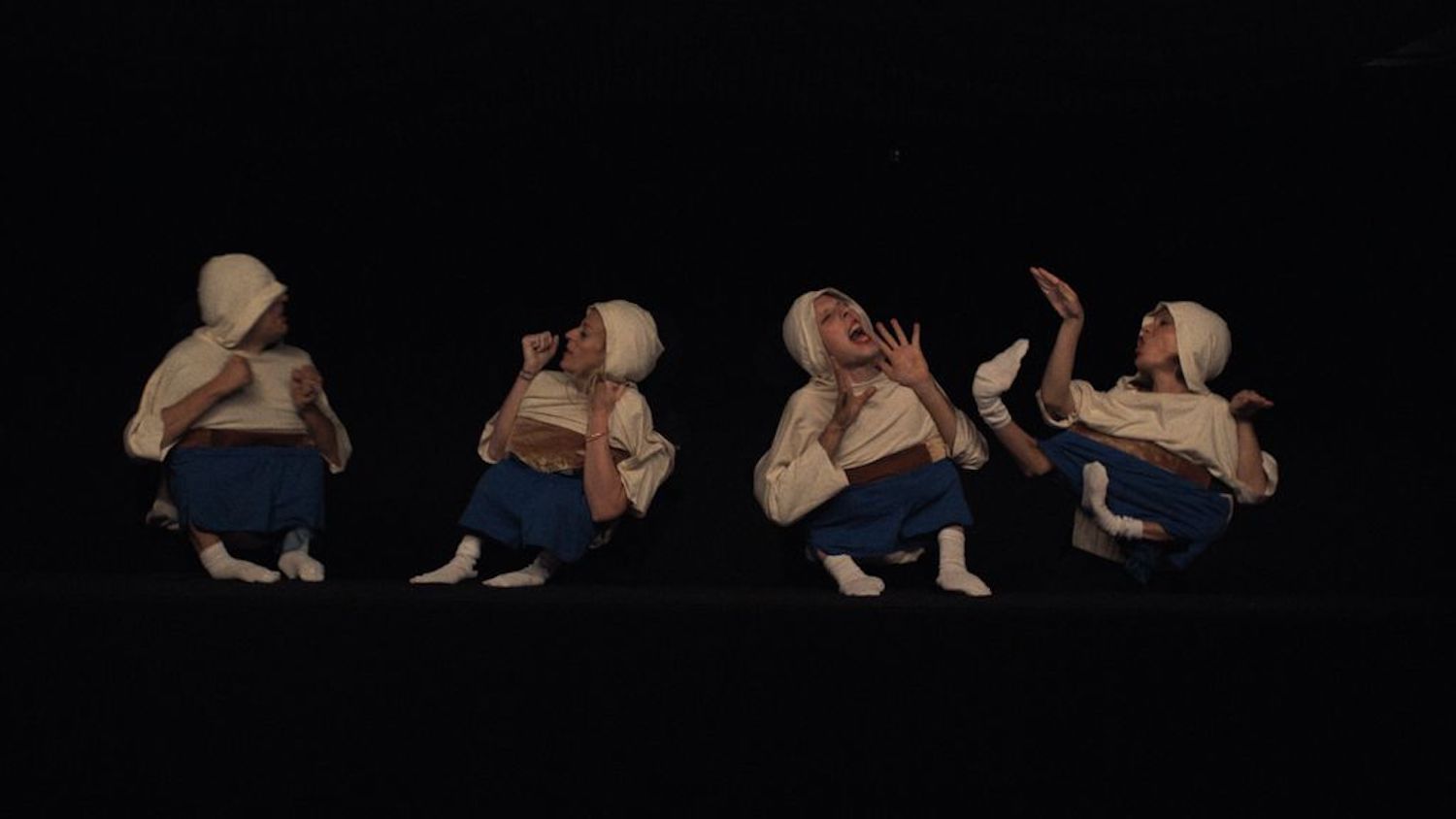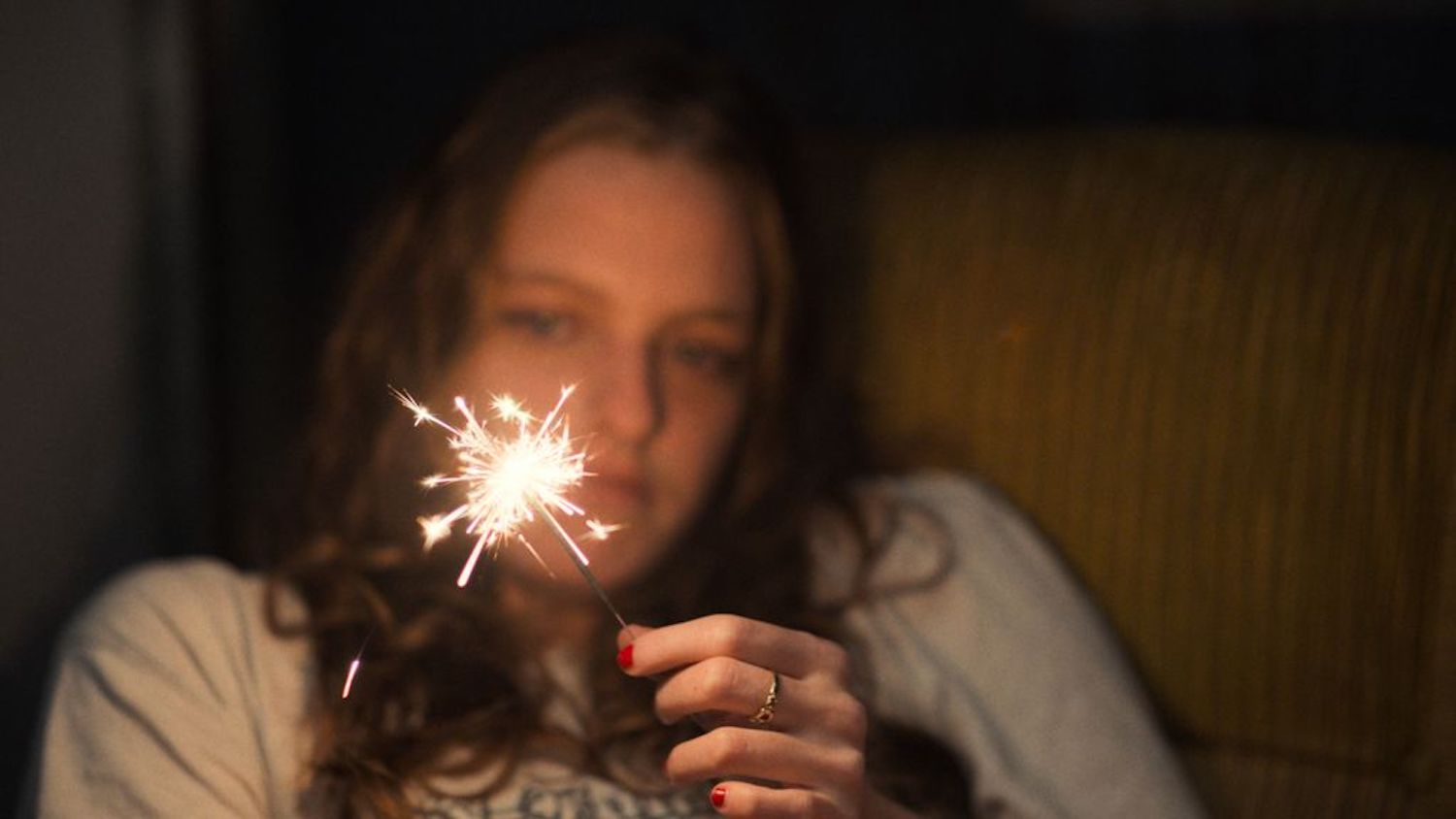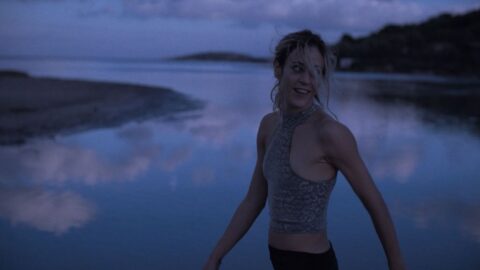Seven years after Park (2016), a searing portrait of disillusioned youths hanging around an abandoned Olympic stadium, Sofia Exarchou returns with Animal (2023), a gripping character study about a talented dancer. Stuck living a Groundhog Day-like (Harold Ramis, 1993) existence, she entertains guests day-in, day-out at a mid-level, all-inclusive Greek resort. Dimitra Vlagopolou stars as Kalia, an “animateur” who takes newcomer Eva (Flomaria Papdaki) under her wing for another debaucherous summer filled with boozy nights and casual sex, sending both on a dark journey of self-discovery. Impressed by the film in our first-look review, we had to catch up with Exarchou to talk about Euro capitalism, shooting difficult sex scenes and choosing the right karaoke song.
Animal is a film about performance — about these animateurs putting on a smile and entertaining people no matter what they’re feeling inside. What made you want to explore this specific group of resort workers?
Actually, I didn’t start out with the animateurs — I first started thinking about the tourist system and how I wanted to make a film about working systems under capitalism. Tourism is the cornerstone of the Greek economy and I see how the tourism machine plays out every year on the islands. I wanted to comment on people working under those harsh conditions. I also wanted to explore entertainment and how this concept is so important in capitalism — how you have to entertain people all the time. I also felt quite related to it because of my job as a filmmaker and I was thinking about what it means to make people enjoy something and stuff. For me, any kind of worker has to put on a costume every day — they have to deliver for however many hours every day, and maybe smile for the CEO or the client or whatever. We actually put on a specific costume and smile like clowns. We have to deliver the energy, sometimes through dancing and singing, but for me, in the end, it’s always about workers entertaining people.
Your film keeps its attention squarely on these workers. Was this always the plan, or were there drafts where you included more tourist characters, or other people working in the hotels?
Somehow I knew from the beginning that the antagonist was the system — the system as the greater idea — not the bad manager or the bad employee, or the employer who treats them badly or whatever. Just the idea of the system, the more general picture. The same goes for the tourists. For me, they were not the antagonists. Because of the system, there will always be tourists; the people who have to be on that side of this structure. The resort in the film is like a B/C class resort with cheap tourism; it’s not like a high-class hotel. These are also people who have to escape from their structure and from their system to relax for a couple of days.
What kind of research did you do to gain insight into the lives of these animateurs?
I watched a lot of animateurs in Greek hotel resorts but also a lot of stuff on YouTube because it’s a great research machine. I saw animateurs in Latin America, animateurs on cruise boats, basically wherever they can exist, in order to get more and more inspired. I still remember the first time I went to a hotel resort. When I saw this two-hour show with back-to-back gags, I was completely convinced that I knew my story and I could feel all the emotions surrounding it.
Is there a lot of tension between locals and tourists in Greece? I imagine having your home being such a popular vacation destination can cause a bit of resentment. I used to live in Barcelona and you could always feel that tension.
Yeah, there is. I don’t know if tourism will collapse in Greece. I don’t know what will happen with the economy. It’s something that we hate and love. For me, the most interesting thing is how completely some places change between summer and winter. I did this scouting where I was filming on the island of Crete and during the winter, it was a no man’s land. And then you cannot even believe the madness of summer — I couldn’t believe I was on the same roads. So yeah, it’s like the whole country is a big theme park. And with specific elements, like, “Okay, we’ll have to exploit our ancient culture! What will drag them here, how do we compete with a place like Spain? What do we have to provide?” So that keeps going for some months and then it’s dead until the next year when we have to open up for the show again.

Dimitra Vlagopoulou’s performance is so nuanced and authentic. Tell me about working with her and your process together. Are you big on improvisation or do you stick closely to a script? I heard she’s a trained dancer!
She started at the national dancing school in Athens, but also studied at the international acting school and she was also an athlete in gymnastics when she was really young. Now she mainly works as an actress.
We worked together on my first feature Park and when I started writing the script for Animal, I felt like her character in that had some vague connection with the one from Park. Like: “Where would we find her 10 years after?” That was definitely an inspiration as a starting point, you know, the liberation of this character. So, she was always in my mind. I knew that whoever played Kalia had to have really good dancing and acting skills to manage to deliver on this character, which is quite a difficult one with a lot of layers and nuances. So we worked with her, but also with the actors doing improvisation where we tried to touch in the first level, all the main scenes, but also for them to realise the whole universe, including the dynamics between them.
In the film, they’re like this weird family that they have been for many years together and I wanted to have the audience have this feeling of a family. So I wanted to take time together and to build on these dynamics between them and also elaborate on all the layers of Kalia’s character… how strong she is on one side, but also how vulnerable she is and all of the things she’s hiding and not facing.
We worked a lot with the choreographer for the show scenes, because it was important to add the body element but also for them to realise exactly what are these inanimate characteristics because it’s very different for an actor or a dancer. We spent almost two months doing the dance show stuff and then we went back to the acting rehearsals.
The character Kalia often uses sex as an escape from a sort of loneliness or general displeasure with her life. I’d love to learn more about creating sex scenes that are touched with a little bit of sadness and discomfort.
We talked a lot about how one of the only ways she receives acceptance or pleasure is through sex, and how she is accustomed to the positive gaze that she gets in the club when she looks at the audience and sees how she’s admired like a sex object. It’s important for the audience to realise that that’s how she feels about it, that for her, it is a tool that she is using to feel better, to feel alive and accepted. But we can see that she doesn’t want to confront what lies underneath, that the sex cannot deliver all the joy she needs and that’s where the sadness comes from. Sex is kind of a double-edged sword and it cannot actually save her. There’s some small relief, but it’s gone within two seconds.
I loved the sort of mirror you held up between Kalia and the younger Polish woman, Eva, and also the young child character Mary. Was it your intention to have them all be different versions of the same person who will be caught up in this profession?
Yeah, it was like that from the beginning. I knew that my main character was somebody who has been in this world for many years, someone stuck working in this system. I wanted to explore the exhaustion and what it means to be unable even to distinguish yourself from the characters you play every night. I knew that my main character would be on this journey of realisation. Then I had an idea of the second female character, Eva, who has the opposite journey, meaning that she doesn’t yet know anything about this world. Through the film, she will discover the layers of this universe, but her intention is to be accepted to enter this world and to find a place to work and find her own life. It’s a coming-of-age thing.
There are these two opposite journeys. I found it interesting that one wants to be there and the other has realised that she cannot survive there anymore. Then I thought: “What if I have also this little kid, another female character who was born there?” Like kids born into the circus and always moving with the circus who don’t know of any other universe.
I was trying to make the idea of the similarities more abstract, more in an open way, but not exactly the same. Everybody has their own backstory and their own story in general. But somehow I think the way it is structured in the film, every viewer can fill in the gaps and understand the loneliness that each of these characters carries with them while having some similar characteristics and some differences.
Music plays a huge role in the film and you use kitschy songs like “Let’s Get It On” and “Yes Sir, I Can Boogie” to communicate a deeper sadness in the characters. Why did you make these choices and what do they mean to the film?
I wanted to be realistic with the stuff we hear in this kind of environment — it’s kind of repetitive every year and you hear the same songs again and again. This was such an important element of creating this universe, but it was very exhausting. When I wrote the first list, it was almost like 40 songs. One of the big main songs, “Yes Sir, I Boogie”, I would say, was the most difficult to decide. People will think that it was there from the beginning, but not at all. It was not there from the beginning.
The scene was there but we didn’t know the song. As the months went by, I didn’t want to decide and the burden was even bigger. When you delay this kind of big decision, when it’s a song that has to deliver these big feelings and has to be a strong moment for the character, it becomes a huge worry. “Yes Sir, I Can Boogie” was always really strong in my heart because it was like, “Okay, I could imagine Kalia delivering it with this emotion and also because of the lyrics, because there’s also something really female and vulnerable about it.”
It was really interesting to have your Polish character sing an old Soviet song like “A Million Roses.” Was it your intention to create this odd, culturally conflicting moment for her?
Yes, totally and I think it’s really interesting that you pose this question because I think it’s one of these details that maybe some viewers will miss. It was really interesting for Eva’s story to end not with all the images that we see…like how she’s changed and she’s like a grown woman now, and how she’s found this new life and somewhere to belong. In the end, she’s still just a Polish girl who sings a Russian song in front of an audience. It’s a nice little detail for her story, but also for the whole allegory of this place.

And one last important question: What is your personal favourite karaoke song?
Oh, very important! I have a really bad voice — I can’t sing. I am completely out of tune, like completely out of tune. “Yes Sir, I Can Boogie” became the anthem of the crew because the shooting was so difficult. So that song meant to us like, “We will survive, we will finish this fucking film, we will go on until the end.” So maybe after this experience, maybe I would sing that song, but still in my very own bad way.
Jared loves movies and lives with Kiki in Berlin.
